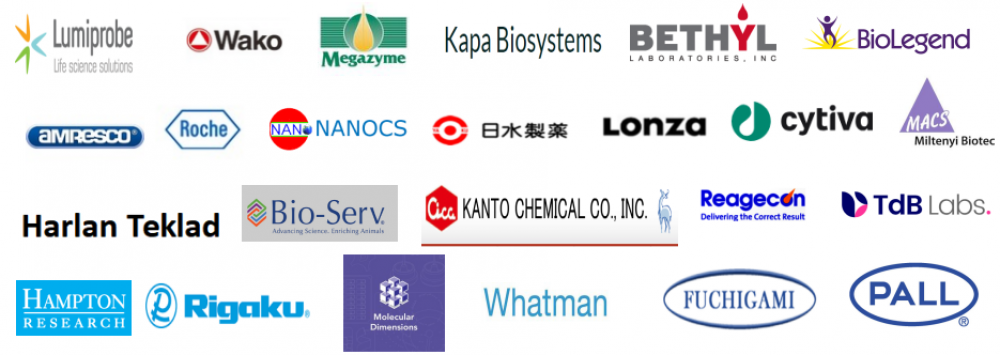品牌:Bioss/博奥森 | 货号:JP-10589R
| 产品编号 | JP-10589R |
| 英文名称 | Collagen II |
| 中文名称 | Ⅱ型胶原蛋白抗体 |
| 别 名 | Collagen II alpha 1; COL2A1; COL2A1 protein; collagen, type II, alpha 1; collagen alpha-1(II); type II collagen; alpha-1 type II collagen; alpha1 type II collagen; Col2a1; AOM; Cartilage collagen; Chondrocalcin; COL11A3; Collagen alpha 1(II) chain precursor; Collagen II alpha 1 polypeptide; Collagen type II alpha 1 (primary osteoarthritis spondyloepiphyseal dysplasia congenital); MGC131516; SEDC; CO2A1_HUMAN. |
|
Specific References (7) | JP-10589R has been referenced in 7 publications.
[IF=4.263] Wu X et al.The role of Ca 2+ in acid-sensing ion channel 1a-mediated chondrocyte pyroptosis in rat adjuvant arthritis.(2018) Lab Invest. WB ; Rat .
PubMed:30487596
[IF=3.76] Shi, Yang, et al. “Hypoxia combined with spheroid culture improves cartilage specific function in chondrocytes.” Integrative Biology 7.3 (2015): 289-297. Rat.
PubMed:25614382
[IF=2.784] Ma C et al.Isolation and biological characteristic evaluation of a novel type of cartilage stem/progenitor cell derived from Small‑tailed Han sheep embryos.Int J Mol Med. 2018 Jul;42(1):525-533. ICF ; Sheep.
PubMed:29693133
[IF=2.348] Ren et al. Treatment of rabbit intervertebral disc degeneration with co-transfection by adeno-associated virus-mediated SOX9 and osteogenic protein-1 double genes in vivo. (2013) Int.J.Mol.Me. 32:1063-8 WB ; Rabbit.
PubMed:24045878
[IF=0] Xu et al. Treatment with SiMiaoFang, an anti-arthritis chinese herbal formula, inhibits cartilage matrix degradation in osteoarthritis rat model. (2013) Rejuvenation.Re. 16:364-76 IHC-P ; Rat.
PubMed:23799821
[IF=0] Yang et al. Isolation and biological characterization of tendon-derived stem cells from fetal bovine. (2016) In.Vitro.Cell.Dev.Biol.Ani. 52:846-56 IF(ICC) ; Rat.
PubMed:27130678
[IF=] Luo P et al. IL-37b alleviates inflammation in the temporomandibular joint cartilage via IL-1R8 pathway. Cell Prolif. 2019 Sep 27:e12692. IHC-P ; Rat.
PubMed:31560411
|
|
| 研究领域 | 肿瘤 细胞生物 免疫学 |
| 抗体来源 | Rabbit |
| 克隆类型 | Polyclonal |
| 交叉反应 | Human, Mouse, Chicken, Dog, Pig, Cow, Horse, Rabbit, |
| 产品应用 | WB=1:500-2000 ELISA=1:500-1000 IHC-P=1:100-500 IHC-F=1:100-500 ICC=1:100-500 IF=1:100-500 (石蜡切片需做抗原修复) not yet tested in other applications. optimal dilutions/concentrations should be determined by the end user. |
| 分 子 量 | 117kDa |
| 细胞定位 | 细胞外基质 分泌型蛋白 |
| 性 状 | Liquid |
| 浓 度 | 1mg/ml |
| 免 疫 原 | KLH conjugated synthetic peptide derived from human Collagen II:231-330/1487 |
| 亚 型 | IgG |
| 纯化方法 | affinity purified by Protein A |
| 储 存 液 | 0.01M TBS(pH7.4) with 1% BSA, 0.03% Proclin300 and 50% Glycerol. |
| 保存条件 | Shipped at 4℃. Store at -20 °C for one year. Avoid repeated freeze/thaw cycles. |
| PubMed | PubMed |
| 产品介绍 | Collagens are highly conserved throughout evolution and are characterized by an uninterrupted “Glycine-X-Y” triplet repeat that is a necessary part of the triple helical structure. For these reasons it is often extremely difficult to generate antibodies with specificities to collagens. The development of type specific antibodies is dependent on NON DENATURED three dimensional epitopes. This may result in diminished reactivity of some antibodies with denatured collagen or formalin fixed, paraffin embedded tissues. Type II collagen is a fibrillar collagen found in cartilage and the vitreous humor of the eye. Collagen type II is essential for the normal embryonic development of the skeleton, for linear growth and for the ability of cartilage to resist compressive forces. Mutations in this gene are associated with achondrogenesis, chondrodysplasia, early onset familial osteoarthritis, SED congenita, Langer Saldino achondrogenesis, Kniest dysplasia, Stickler syndrome type I, and spondyloepimetaphyseal dysplasia Strudwick type. In addition, defects in processing chondrocalcin, a calcium binding protein that is the C propeptide of this collagen molecule, are also associated with chondrodysplasia. There are two transcripts identified for this gene.
Function: Subunit: Subcellular Location: Tissue Specificity: Post-translational modifications: DISEASE: Similarity: SWISS: Gene ID: Database links: Entrez Gene: 1280 Human Entrez Gene: 12824 Mouse Entrez Gene: 25412 Rat Omim: 120140 Human SwissProt: P02458 Human SwissProt: P28481 Mouse SwissProt: P05539 Rat Unigene: 408182 Human Unigene: 2423 Mouse Unigene: 10124 Rat Important Note: |
| 产品图片 |
Sample:
293T(Human) Cell Lysate at 30 ug A549 (Human) Cell Lysate at 30 ug LOVO (Human) Cell Lysate at 40 ug MCF-7 (Human) Cell Lysate at 30 ug HepG2 (Human) Cell Lysate at 30 ug Primary: Anti-Collagen II (JP-10589R) at 1/300 dilution Secondary: IRDye800CW Goat Anti-Rabbit IgG at 1/20000 dilution Predicted band size: 117 kD Observed band size: 117 kD Sample:
MG63 (Human) Cell Lysate at 30 ug Primary: Anti-Collagen II (JP-10589R) at 1/300 dilution Secondary: IRDye800CW Goat Anti-Rabbit IgG at 1/20000 dilution Predicted band size: 117 kD Observed band size: 117 kD Paraformaldehyde-fixed, paraffin embedded (mouse ear); Antigen retrieval by boiling in sodium citrate buffer (pH6.0) for 15min; Block endogenous peroxidase by 3% hydrogen peroxide for 20 minutes; Blocking buffer (normal goat serum) at 37°C for 30min; Antibody incubation with (Collagen II) Polyclonal Antibody, Unconjugated (JP-10589R) at 1:400 overnight at 4°C, followed by a conjugated secondary (sp-0023) for 20 minutes and DAB staining.
Tissue/cell: Mouse embryo tissue; 4% Paraformaldehyde-fixed and paraffin-embedded;
Antigen retrieval: citrate buffer ( 0.01M, pH 6.0 ), Boiling bathing for 15min; Block endogenous peroxidase by 3% Hydrogen peroxide for 30min; Blocking buffer (normal goat serum,C-0005) at 37∩ for 20 min; Incubation: Anti-Collagen II Polyclonal Antibody, Unconjugated(JP-10589R) 1:100, overnight at 4∑C, followed by conjugation to the secondary antibody(SP-0023) and DAB(C-0010) staining |
本网站可提供的所有产品和服务均不得用于人体或动物的临床诊断或治疗,仅可用于科研等非医疗目的。
